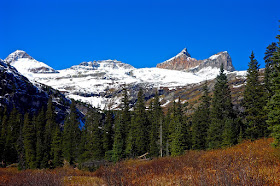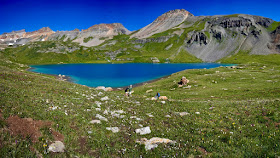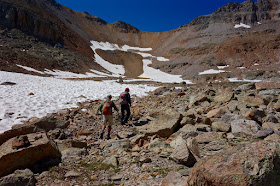Travel: From Norwood, Co in a 4WD vehicle with high clearance and sturdy tires, drive 1.5 miles east. At the junction of CO 145 and CR 44Z S, Lone Cone Road, zero-out your trip meter and turn south. The paved road turns to good gravel at 10.6 miles where it crosses the US Forest Service Boundary and becomes FSR 610. Lone Cone views enhance the drive. Begin in ranching country, progress through piñon-juniper forests, vast aspen groves, and finally, conifer. At 12.0 miles, turn left/east on CR M44, Beef Trail Road. At 14.5 miles, turn right on FSR 611. Enter the Uncompahgre National Forest at 16.6 miles. Stay straight at 16.8 miles. At 19.5 miles, bear right at the junction with Beaver Park Road. At 21.2 miles, turn right on FSR 612. The dirt road is rocky, rough, has deep ruts, and is muddy when wet. Vehicles with moderate clearance should park at the junction with 612 1B at 24.5 miles and walk up the road to the trailhead, or take the Red-Line Route. High clearance vehicles may park at the designated trailhead at 25.5 miles. There is plenty of good parking on the left. The trail is marked with a Forest Service multi-use sign post. Allow 1:15 from Norwood.
Distance and Elevation Gain: 5.0 miles; 2,100 feet of climbing for the standard route
Time: 3:30 to 5:00
Difficulty: Trail, off-trail; navigation moderate; Class 2+ on talus; no exposure
Maps: Beaver Park; Lone Cone, Colorado 7.5 Quads
Latest Date Hiked: August, 22, 2015
Reference: For the challenging, northeast ridge scramble, consult: Colorado Scrambles: Climbs Beyond the Beaten Path, Dave Cooper, Colorado Mountain Club.
Quote: The path of the axis, in an ascending direction, therefore indicates the path of escape from the massive compression and diffuseness of the base towards the concentration and unrestricted freedom of the apex. Marco Pallis
The northface of Lone Cone has a powerful gleaming presence when experienced from Devils Chair.
Route: When I first climbed Lone Cone in 2003, there was no trail and we started overland on the Red-Line Route from FSR 612 1B. FSR 612 was intentionally blocked. We took the Blue-Line Route because we wanted to hit the north ridge as low as possible. In 2015, an official trailhead is located one mile further up 612. While maps do not depict a trail, there is a strong track for a good portion of the standard Black-Line Route. The Red and Blue-Line Routes are described at the end of this post.
Trailhead 10,800' begins at a multi-use signpost. The trail is open to hikers and equestrians.
Walk southwest on a closed two-track for 0.2 mile. The Lone Cone trail departs from the left/south side of the abandoned road, marked with a post. The perfectly good undocumented trail, augmented with cairns, gently climbs the rounded ridge. Views of Lone Cone are intermittent between the trees.
Pass just west of Knoll 11,230' and come to a small saddle at 0.9 mile. In 2015, we departed from here on the Blue-Line Route. However, if you do this route at all, I suggest taking it on the return. While pleasant, especially for those who favor loops, it is not the most efficient way to climb the mountain and there are navigational challenges. For the standard route, continue south beside a shale slope, following the footpath into heavy woods.
The footpath meanders some while holding to the ridge, gently climbing 400 feet. The trail weaves through downed timber in a manner that signifies deliberate construction.
In late August, traipse through a riot of lavender trail flowers.
At 1.3 miles and 11,560 feet, emerge from the forest on the northeast shoulder of the mountain. The peak's disordered raggedness and the interplay of granitescape and luminescence is enrapturing. Here we depart from the northeast ridge route which continues up the taper. (THW, photo)
Search out a cairn and a faint accompanying trail. If you don't find it, no worries. Just hold to the contour at about 11,600 feet, curving southwest to abut the east side of Devils Chair. At 1.5 miles, arrive at the edge of the rock glacier marked with a three foot cairn, image-center. The route traverses the glacier and then climbs to meet the north ridge in the krumholtz, pictured.
Create your own course while crossing the 0.3 mile glacier. I like to meander, paying visits to fractured igneous blocks that appeal to me. The mountain flakes off huge chunks to cleave polished, concave faces glistening in the sun. Despite the chaos, I feel embraced within the arms of the mountain. In 2015, the scene was utterly silent; in 2003, the distinctive sound of water running under stone enhanced the experience.
Maintain approximate elevation, reaching the other side at about 11,600 feet. Off-trail, climb a short, comfortable pitch to the north ridge at 1.9 miles, 11,650 feet. Stunted spruce, doing their krumholtz thing, spread out over the ground.
A subtle social trail goes up a shale surface sprinkled with flat talus, decorated with dotted saxifrage and clusters of little gentian. Alpine flora is sparse above timberline at 11,700 feet.
The dwindling trail disappears into chunky, rugged talus at 11,880 feet. Freeze-thaw has sliced stones according to their fine-grained crystalline structure. Flat plates create a stairway. Some teeter-totter. This is heaven for talus fanciers. The ridge is never too steep or exposed.
In 2015, the American West is on fire so visibility was severely compromised. We couldn't see the nearby Abajo or La Sal Mountains and could barely make out the La Plata Range, our home mountains. On a clear day, circle around and identify Grand Mesa, the West Elks, Mount Sneffels Wilderness, and Sleeping Ute Mountain. Below, Little Cone is in the foreground, the San Miguel Mountains are to its right, and the Lizard Head Wilderness is in the background. The peak arises from green meadows painted yellow with golden eye, a late-summer bloomer.
Get a good look at the northeast ridge scramble from the summit. Climbers who ascend this ridge take the standard route down.
Return as you came. The image below gives an overview of the entire route.
The rocks on the upper half of the mountain are extrusive igneous volcanics. However, despite its conical appearance, Lone Cone is not a volcano.
Blue-Line Route: This route is a one mile option on the way back for hikers who are navigation savvy. Continue down the north ridge through elk habitat to 11,500 feet. Do a descending traverse through scattered trees to the drainage west of Devils Chair at 11,200 feet. The glacier takes a precipitous dive below this elevation. Climb the embankment onto the open rock. The mass folds in waves; big fellows are on the move. You will need to get close to the toe of the glacier to negotiate the steep wall on the east side. Don't drop any lower than 11,100 feet. The image below looks back on the north ridge.
Walk east, wading through arrowleaf senecio and delphinium, clambering over deadfall. Skirt the top of a secondary drainage and then climb 200 feet to rejoin the standard trail just south of Knoll 11,230'.
Red-Line Route: For those who need to park here because of vehicle limitations, it is actually easiest to walk up the main road to the trailhead. If you want to take the Red-Line Route, an off-trail short-cut, walk south on 612 1B and skirt north of a pond at 0.2 mile. Leave the road and climb steeply west-southwest to Knoll 11,230'. Go over the top and join the standard route at about 0.7 mile.
Many of us look at Lone Cone from far and wide for decades before we climb this remote peak. From miles away, it is a regal place keeper. Up close, it is magical.































































